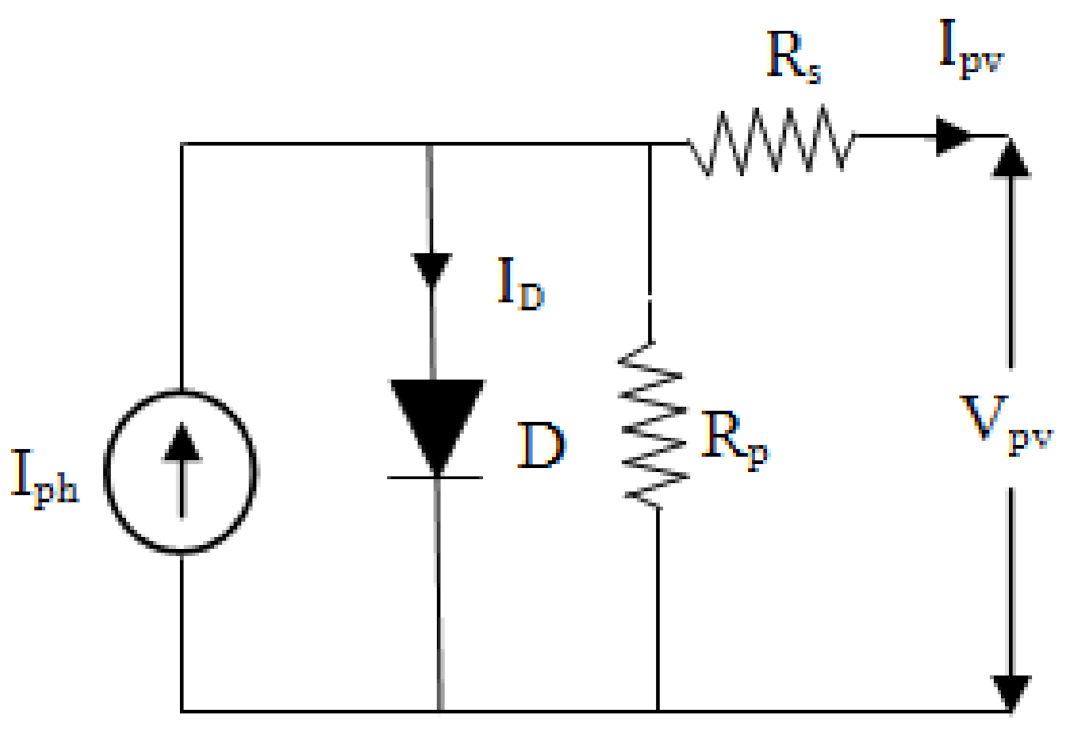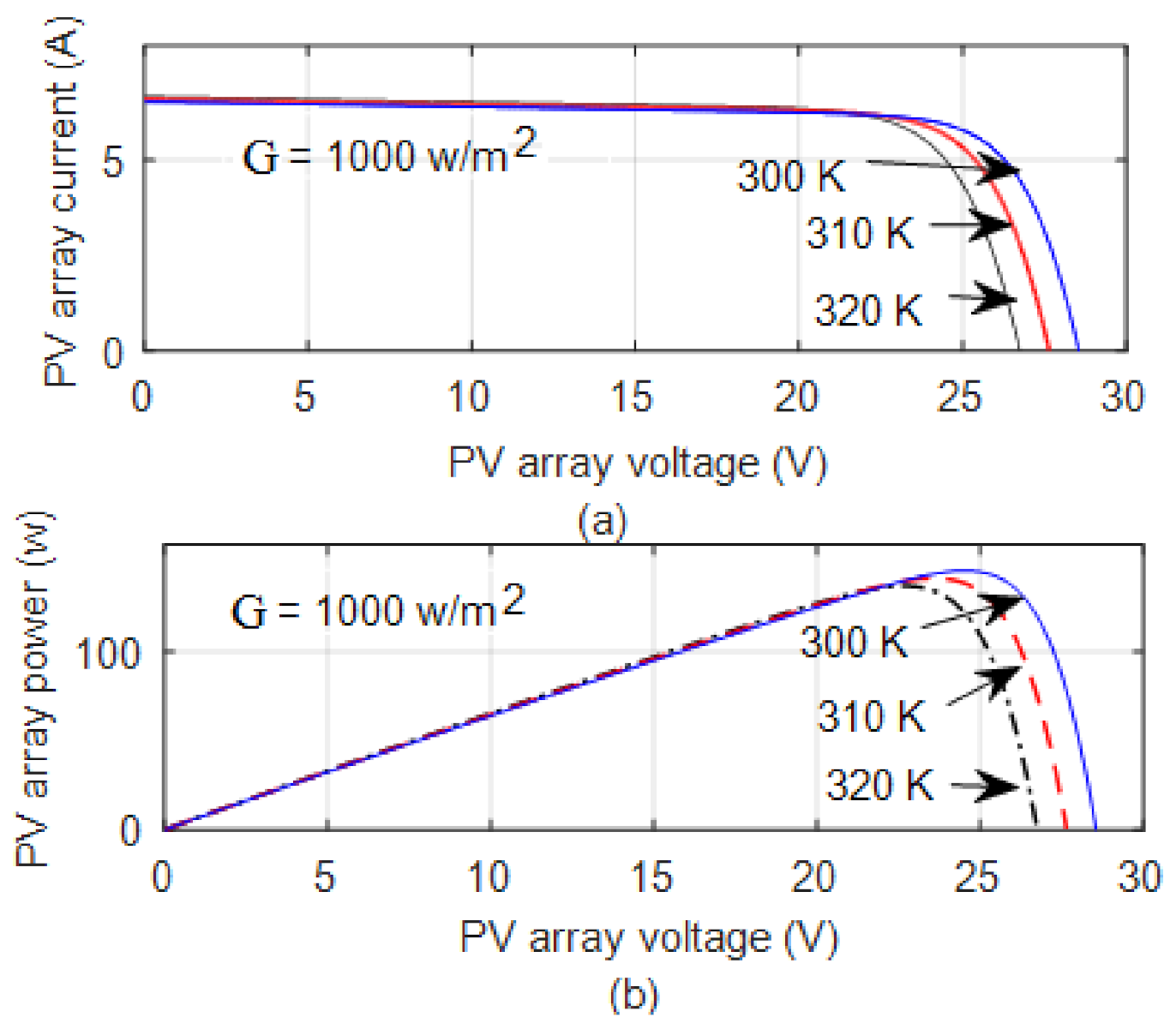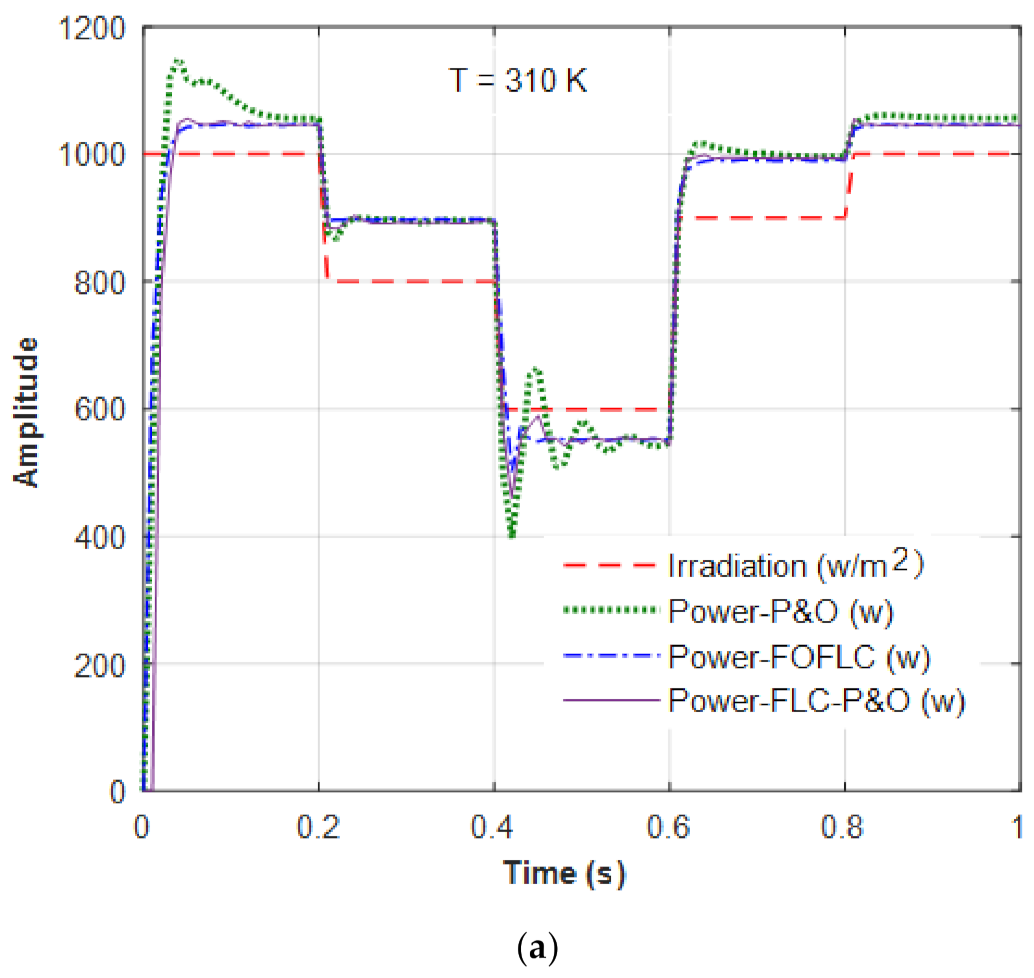2.1. The PV Cell Modeling
The equivalent circuit of the PV model is represented with a current source, diode and resistor combination, as shown in
Figure 1. The current flowing out of a PV cell can be expressed as
where I
D is the diode current in A, and I
ph is the photocurrent in A. The PV module is usually produced with series and parallel connected solar cells. The above Equation (1) is rewritten as
where I
sat represents the reverse saturation current in A; V
pv denotes output voltage in V; q denotes the charge of an electron in C; k denotes the Boltzmann constant (1.3806 × 10
−23 JK
−1); T denotes the cell temperature in K; N
p and N
s denote the number of the parallel and series-connected PV cells, respectively; and n denotes the diode ideality factor. The I
sat is sensitive to the T, which is expressed as
where T
ref denotes the standard temperature (300 K) in K, I
s denotes the short-circuit current in A at standard temperature, I
rev denotes reverse saturation current in A at standard temperature, e denotes energy in energy gap, k
s denotes temperature coefficient in %/K of I
s and G denotes the irradiation in w/m
2.
The PV module efficiency was determined using the ratio of the power output to the area of PV panel absorbing solar irradiation [
25]; it is expressed as
where P
pv denotes the PV module output power in w and A
P denotes the area of cross-section of the PV panel in m
2.
The PV model was developed using MATLAB software based on the aforementioned theoretical background; the design parameters of the PV model are shown in
Table 1. The designed model validation was conducted by verifying the PV cell output characteristics, namely, power versus voltage (P–V) and voltage versus current (I–V). The characteristics of the designed PV model for the different temperatures with assumed solar irradiation of 1000 w/m
2 were plotted as shown in
Figure 2a,b. The accuracy of the designed PV model was confirmed by comparing its output with the manufacture datasheet; the percentage of deviation is within 2%, as shown in
Table 2.
2.2. Modeling of the TEG
Thermoelectric generators are usually constructed with series-connected TEs; a typical structure of the TEG is shown in
Figure 3.
Figure 4 shows the electrical equivalent circuit of the TEG; the voltage induced in a TEG based on the Seebeck effect is given as
where S is the Seebeck coefficient in V/K, TH is the hot-end temperature in K and TC denotes the cold-end temperature in K. The Seebeck coefficient can be determined from the following expression
where N
t denotes the number of thermocouples; s
p and s
n denote the Seebeck coefficients for p-type and n-type TE, respectively. The voltage, current and power output of the TEG can be given as
where R
L denotes the load resistance in Ω, and R
int is the TEG internal resistance in Ω. The internal resistance of the TEG can be calculated from the following expression
where σ is the electrical conductive of thermocouple in S/m, σ
C is the electrical conductive of the copper strip, A
t is the area of cross-section of TE in m
2, A
C is the area of cross-section of the copper strip in m
2, L is the thermocouple length in m and L
C is the length of copper strip in m.
In this energy conversion process, the TEG collects heat flux at the hot end and releases the heat flux at the cold end. During the energy conversion, the Seebeck effect plus two more effects also take place in the TEG, the Peltier effect causing heat due to the current flow and the Thomson effect causing heat because of the temperature difference between two ends of the TEG and current flow. However, the Thomson effect is ignored because of its low impact on the output; the TEG energy equation is expressed as [
1]
where q
H and q
C are the energy at hot and cold ends of the TEG, respectively, which are expressed as
where k
t is the thermal conductance of the TEG (w/K); the terms SIT
H and SIT
C represent the heat flux at hot and cold ends of the TEG, respectively. The model of the TEG was developed using the thermal and electrical properties of the thermocouple; the familiar bismuth telluride Bi
2Te
3-type thermocouple was chosen in the present study. The areas and lengths of p-type TE and n-type TE were assumed to be equal. The temperature-dependent parameters of the Bi
2Te
3 thermocouple were considered from the datasheet and Qing et al. [
26]. The design parameters of the Bi
2Te
3 thermocouple for the reference temperature of 300 K are shown in
Table 3. The performance of the TEG is usually determined using the figure-of-merit, which is expressed as
Similarly, the efficiency of TEG was determined by the ratio of the power generated for the input thermal energy,
Thermal properties of the p-type and n-type TEs were studied for the temperature range of 300 to 450 K, as shown in
Figure 5. These characteristic graphs are closely matched with the results presented in [
27] for the Bi
2Te
3 thermocouple. Similarly, the electrical properties of the TEG model were also tested against the temperature difference (ΔT) with an assumed total number of thermocouples (N
t) of 110. The voltage and power output of the TEG against the varying temperature difference of 0 to 50 K is shown in
Figure 6a. From the result, one can understand that the open-circuit voltage (E
teg) of the TEG varies linearly with ΔT and satisfies Equation (6). Additionally, the output voltage (V
teg) is exactly half of the E
teg voltage for the chosen load resistance; R
L is equal to the internal resistance (R
int) of the TEG. According to the theory of maximum power transfer theorem, the load will receive the maximum power when the R
L is equal to R
int and the load voltage (V
teg) is half of the source voltage (E
teg). The proposed TEG model confirmed its electrical performance by satisfying the maximum power transfer theorem. The power output of the TEG is directly dependent on ΔT between the sides (cold and hot) and the connected load at the output side. The maximum power output of the TEG was achieved by maintaining an equal load resistance value to its internal resistance of the TEG. The power output (P
teg) generated versus that shown in
Figure 6a confirms that the TEG output power varies based on the temperature difference between the cold and hot ends. The voltage versus current (V-I) characteristic of the designed model is demonstrated for the different ΔT values of the TEG in
Figure 6b. From the results, it was observed that the voltage output (V
teg) of the TEG is dependent on the temperature difference across the two junctions and confirms Equation (9). For the given Seebeck coefficient, the high ΔT increased the TEG output voltage.


























